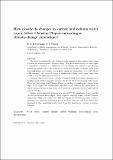| dc.contributor.author | O'Gorman, Paul Ambrose | |
| dc.contributor.author | Muller, Caroline | |
| dc.date.accessioned | 2011-06-23T17:14:01Z | |
| dc.date.available | 2011-06-23T17:14:01Z | |
| dc.date.issued | 2010-04 | |
| dc.date.submitted | 2009-12 | |
| dc.identifier.issn | 1748-9326 | |
| dc.identifier.uri | http://hdl.handle.net/1721.1/64666 | |
| dc.description.abstract | The factors governing the rate of change in the amount of atmospheric water vapor are analyzed in simulations of climate change. The global-mean amount of water vapor is estimated to increase at a differential rate of 7.3% K[superscript − 1] with respect to global-mean surface air temperature in the multi-model mean. Larger rates of change result if the fractional change is evaluated over a finite change in temperature (e.g., 8.2% K [superscript − 1] for a 3 K warming), and rates of change of zonal-mean column water vapor range from 6 to 12% K [superscript − 1] depending on latitude.
Clausius–Clapeyron scaling is directly evaluated using an invariant distribution of monthly-mean relative humidity, giving a rate of 7.4% K − 1 for global-mean water vapor. There are deviations from Clausius–Clapeyron scaling of zonal-mean column water vapor in the tropics and mid-latitudes, but they largely cancel in the global mean. A purely thermodynamic scaling based on a saturated troposphere gives a higher global rate of 7.9% K [superscript − 1].
Surface specific humidity increases at a rate of 5.7% K [superscript − 1], considerably lower than the rate for global-mean water vapor. Surface specific humidity closely follows Clausius–Clapeyron scaling over ocean. But there are widespread decreases in surface relative humidity over land (by more than 1% K − 1 in many regions), and it is argued that decreases of this magnitude could result from the land/ocean contrast in surface warming. | en_US |
| dc.language.iso | en_US | |
| dc.publisher | IOP Publishing | en_US |
| dc.relation.isversionof | http://dx.doi.org/10.1088/1748-9326/5/2/025207 | en_US |
| dc.rights | Creative Commons Attribution-Noncommercial-Share Alike 3.0 | en_US |
| dc.rights.uri | http://creativecommons.org/licenses/by-nc-sa/3.0/ | en_US |
| dc.source | Prof. O'Gorman via Chris Sherratt | en_US |
| dc.title | How closely do changes in surface and column water vapor follow Clausius-Clapeyron scaling in climate change simulations? | en_US |
| dc.type | Article | en_US |
| dc.identifier.citation | P A O'Gorman and C J Muller. "How closely do changes in surface and column water vapor follow Clausius-Clapeyron scaling in climate change simulations?." Environ. Res. Lett. 5.2 (2010): 025207. | en_US |
| dc.contributor.department | Massachusetts Institute of Technology. Department of Earth, Atmospheric, and Planetary Sciences | en_US |
| dc.contributor.approver | O'Gorman, Paul Ambrose | |
| dc.contributor.mitauthor | O'Gorman, Paul Ambrose | |
| dc.contributor.mitauthor | Muller, Caroline | |
| dc.relation.journal | Environmental Research Letters | en_US |
| dc.eprint.version | Author's final manuscript | en_US |
| dc.type.uri | http://purl.org/eprint/type/JournalArticle | en_US |
| eprint.status | http://purl.org/eprint/status/PeerReviewed | en_US |
| dspace.orderedauthors | O’Gorman, P. A.; Muller, C. J. | en |
| dc.identifier.orcid | https://orcid.org/0000-0003-1748-0816 | |
| dspace.mitauthor.error | true | |
| mit.license | OPEN_ACCESS_POLICY | en_US |
| mit.metadata.status | Complete | |
